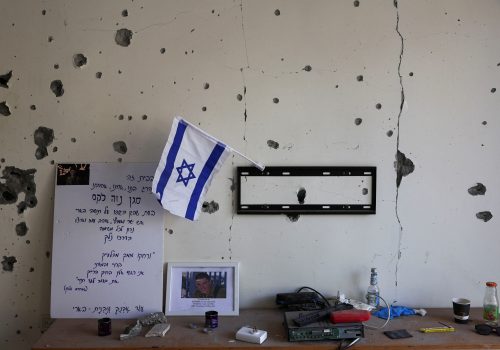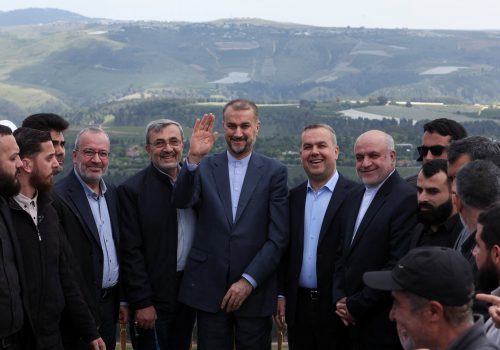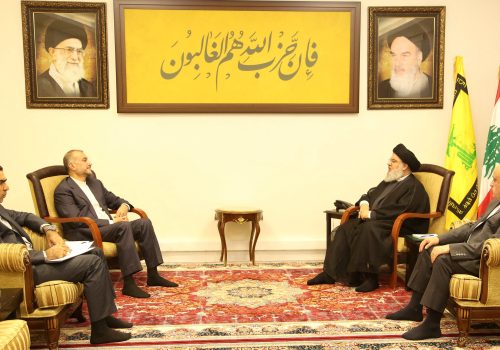ISIS was behind the Kerman attack. Iran still blames Israel and the United States, though.
The January 3 terror attack in Iran claimed by the Islamic State of Iraq and al-Sham (ISIS) was the deadliest since the 1979 Islamic Revolution. Even after the Iranian government revised the total number of deceased persons—at least ninety—downward from 103, it was still higher than the mortalities from the bombing of the Islamic Republican Party’s headquarters in 1981, which resulted in the death of around seventy-four people. The former’s significance will require the Islamic Republic’s establishment to respond, but it will likely do so in a deliberate manner. After ISIS attacks, there is a pattern in the Islamic Republic of publicly blaming the United States and its allies while focusing its kinetic retaliation on ISIS itself.
For years, the political elite of the clerical establishment have argued that ISIS was a creation of the United States and Israel. In 2014, Hossein Amir-Abdollahian, then a deputy foreign minister, charged (without evidence) that ISIS was a creation of Israel’s Mossad intelligence agency. That same year, former Intelligence Minister Heydar Moslehi called ISIS a “triangle of Mossad, MI6, and the CIA.” Iran’s Supreme Leader Ayatollah Ali Khamenei himself maintained publicly that “wicked” Britain and the United States had created the terror organization.
This conspiratorial mindset, which starts at the top, reinforces the Islamic Republic’s need to maintain an enmity with the United States and Israel despite ISIS being a threat to not only Washington and Jerusalem but also Tehran. It was, therefore, unsurprising that, soon after the explosions in Kerman, some Iranian officials started to shift the blame to the US and Israeli governments. President Ebrahim Raisi’s deputy chief of staff tweeted, “Washington says USA and Israel had no role in terrorist attack in Kerman, Iran. Really? A fox smells its own lair first.” At the funeral of the victims of the terror attack, Commander-in-Chief of the Islamic Revolutionary Guard Corps (IRGC), Hossein Salami, made sure to mention that ISIS jihadists “only act as mercenaries for US and Israeli interests.”
US intelligence later assessed that ISIS’s Afghanistan-based branch executed the Kerman bombings. Iranian leaders themselves likely believe that ISIS was behind the Kerman bombings. After all, Iran’s Intelligence Ministry on January 5 acknowledged as such, declaring that “in a short time after the fatal incident, the anonymous soldiers of Imam Zaman discovered the first traces of ISIS terrorist agents.”
But weaponizing the attack against the United States and Israel serves the interests of the Islamic Republic at this sensitive moment in the region. It seeks to capitalize on the slaughter to score propaganda points against the US and Israeli governments at a time when both are under international criticism for the Gaza war. It is also an attempt to bolster the perception of Israel and the United States as enemies of the nation at a time when Iranians have been expressing sympathy for Israel after the October 7, 2023 attack (waning support for the Palestinian cause in Iran is likewise a factor). Additionally, the Islamic Republic’s narrative further serves to fan the flames of hatred towards Israel around the world. This is a conscious decision. The New York Times, according to reporting sourced from IRGC internal deliberations, wrote that, even if a militant group took responsibility for the Kerman attack, Tehran would still publicly hold Israel responsible.
Despite Iran’s bombastic rhetoric, however, its response against ISIS assets will likely be limited. After the 2017 ISIS attack on the Islamic Republic’s parliament and the mausoleum of Ayatollah Ruhollah Khomeini, the founder of the Islamic Republic, Salami—then a deputy commander-in-chief of the IRGC—claimed that “the joint Saudi-Israel-US project was aimed at striking a blow at Iran’s political and security power.” But days later, the IRGC launched missiles solely at ISIS positions in Syria in Operation Laylat al-Qadr.
Fast forward to 2018 and ISIS claimed credit for an attack on a military parade in Ahvaz. There were also regime suggestions that groups like the Arab Struggle Movement for the Liberation of Ahwaz were involved, but the group later denied any role. Then Foreign Minister Mohammad Javad Zarif tweeted that “terrorists recruited, trained, armed, and paid by a foreign regime have attacked Ahvaz. Children and journos among casualties. Iran holds regional terror sponsors and their US masters accountable for such attacks. Iran will respond swiftly and decisively in defense of Iranian lives.” However, despite Iranian charges that it would hold Washington and other governments accountable, the Iranian response was narrowly tailored and focused on ISIS. In Operation Strike of Muharram, the IRGC launched drones and missiles at ISIS targets in Syria.
In the current context, Iran can be expected to mount a similar mixture of fiery speeches—promising revenge against foreign government-sponsored operations in Iran for propaganda purposes—coupled with military action against ISIS targets in the region, potentially even in Afghanistan. If some Iranian decision-makers truly believe in American or Israeli complicity with ISIS, Tehran could also strike targets as it did in 2022 against what it said was a Mossad site in Erbil, putting forth rationales about the alleged existence of Israeli intelligence strategic centers there, which did not result in any costs for Iran. The continued Iranian proxy attacks against US and Israeli interests in the Middle East in the context of the war in Gaza also provide the Islamic Republic an outlet.
These would all be safe responses for Tehran to avoid a decisive American or Israeli retaliation while allowing for it to save face publicly after years of telling its support base that Washington and Jerusalem birthed ISIS. A number of voices in the clerical establishment have been arguing that deterrence has been eroded in recent years given the lack of sufficient responses to Israeli operations—real and imagined—and that a stronger one is required. However, given Khamenei’s modus operandi of carefully calibrated escalation to avoid reprisals on Iranian soil and triggering a direct war with the United States and Israel, which could destabilize his regime, he will likely proceed cautiously in the weeks ahead.
Jason M. Brodsky is the policy director of United Against Nuclear Iran (UANI) and a non-resident scholar at the Middle East Institute’s Iran Program. Follow him on X: @JasonMBrodsky.
Further reading
Thu, Dec 7, 2023
Does the Resistance Axis believe its propaganda about Israel? The October 7 attack seems to suggest so.
IranSource By
For the Resistance Axis, portraying Israel as a temporary entity that will inevitably melt away has an obvious utility, and is one that furthers the goal of destroying the Jewish state.
Thu, Jul 6, 2023
Hezbollah and Iran have opened a fourth battlefront: Inside Israel
IranSource By David Daoud
Critical as recent developments may prove, they obscure a more dangerous Hezbollah initiative to establish a proxy foothold inside Israel.
Thu, Oct 19, 2023
Israel misread Iran’s way of war. A proper understanding could help predict Hezbollah’s next moves.
IranSource By David Daoud
Iran—through Hezbollah—has spent almost two decades and considerable effort and funds building the Gaza Strip into the Axis of Resistance’s Southern Front against Israel.
Image: Iran's President Ebrahim Raisi visit the persons who were injured in January 3 twin blasts in Kerman, at a hospital in the southern city. Raisi joined mourners in Kerman on January 5 for the funerals of the 89 people killed in twin blasts claimed by the Islamic State group, state media said. Photo by Iranian Presidency Office Tehran Tehran Iran, Islamic Republic of 050124_Iran_IPO_1_0012 Copyright: xapaimagesxIranianxPresidencyxOfficexxapaimagesxNo


